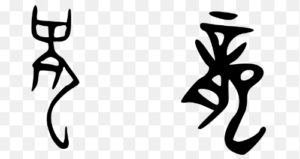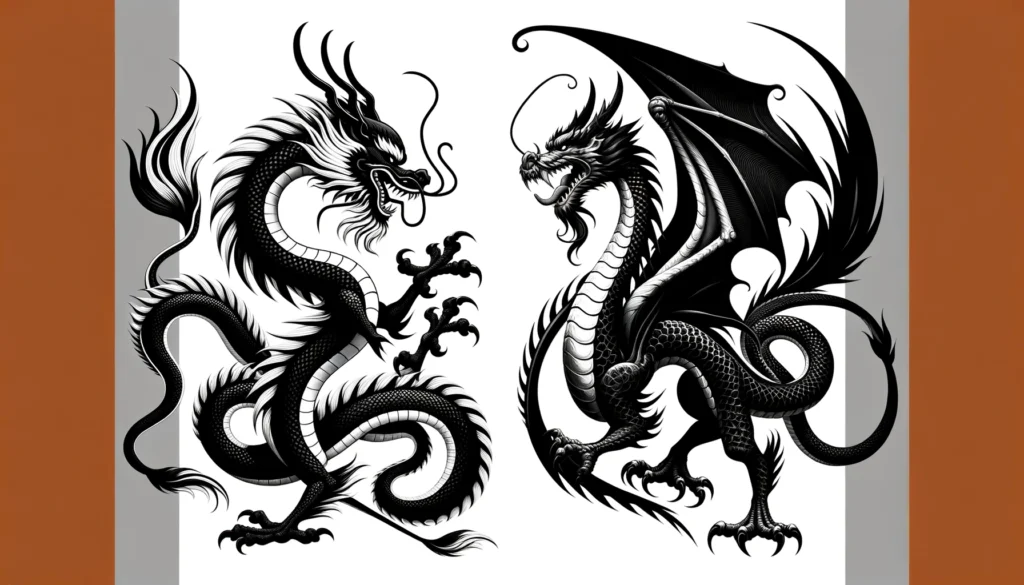Contents
Introduction:
In the vast constellation of ancient Chinese culture, the twelve zodiac animals hold a special place, symbolizing not just the cyclical nature of time but also the rich diversity of life itself. Among these, the Chinese Dragon “龍” (Pinyin: lóng) stands out with its unique mythological identity, distinct from the natural depictions of the other zodiac animals. The choice of the Chinese Dragon in its traditional character form “龍” (Pinyin: lóng), as opposed to the simplified “龙” (Pinyin: lóng) reflects a deep reverence for the historical and cultural depth of this mythical creature. Throughout the evolution of human civilization, the image of the Chinese Dragon has undergone transformations, yet it has consistently symbolized strength, wisdom, and prosperity, whether viewed through ancient texts or from a modern perspective.
The presence of the “龍” (Pinyin: lóng) in the zodiac not only marks humanity’s pursuit of and longing for the transcendent but also signifies an important totem in Chinese culture, carrying the essence of national spirit and values. Its exceptional role highlights the Chinese understanding and respect for the delicate balance between mythology, dreams, and reality. This article aims to explore the symbolic significance of the “龍” (Pinyin: lóng) its manifestations in Chinese philosophy, art, history, and contemporary culture, and how, as a cultural symbol, it continues to exert influence across time and space.
The Origin of the “龍” Chinese Dragon: Unveiling the Legend
Tracing the “龍” (Pinyin: lóng): A Journey from Oracle Bones to Seal Scripts

Chinese Dragon of Oracle Bone inscriptions and Chinese Dragon of Bronze inscriptions

Chinese Dragon of Long Seal script and Chines Dragon of Modern Characters
The Chinese dragon, or “龍” (Pinyin: lóng), has its depiction evolved through the ages, from Oracle Bone inscriptions, Bronze inscriptions, to Seal script. This evolution reflects the dragon’s growing significance in Chinese culture, mirroring the development of Chinese script itself. The transformation from the primitive etchings on oracle bones to the more sophisticated Seal script “龍” (Pinyin: lóng) symbolizes not just the artistic advancement but also the deepening of the dragon’s cultural and spiritual significance.
The simplified character “龙” (Pinyin: lóng) is a reduced form of “尨” (Pinyin: lóng), which is actually the cursive script of “龍”(Pinyin: lóng). Personally, I believe there was no necessity to transform “龍” into “龙” as the simplified character. Chinese script is vast and rich, but for those characters that hold exceptional importance to everyone, whether in traditional or simplified form, the appearance of “龍” represents the entirety of human imagination.
The Chinese Dragon’s Zodiac Journey: Symbolism and Significance
The origins of the twelve zodiac animals trace back to the Spring and Autumn period, a pivotal era that saw the formal inclusion of the “龍” (Pinyin: lóng) in Chinese mythology and the zodiac system. This historical milestone signifies the “龍” (Pinyin: lóng) official recognition as a symbol of power, wisdom, and prosperity. The inclusion of the Chinese dragon in the zodiac not only highlights its importance in Chinese astrology but also cements its status as a cultural icon, embodying the dreams and aspirations of the Chinese people across generations.
Imperial Majesty of the “龍” Chinese Dragon: Evolution and Symbolism
Claws of Power: Deciphering the Dragon’s Evolutionary Significance
The depiction of dragons in Chinese culture has undergone several transformations throughout history, notably in the number of claws, from three and four to the Qing Dynasty’s five-clawed dragons. Each variation in claw count signifies different ideologies and social standings. The three-clawed dragon, often associated with Japanese royal emblems, symbolizes the Emperor’s power; the four-clawed dragon was commonly used among nobles and high officials in ancient China, denoting their esteemed status. By the Qing Dynasty, the five-clawed dragon became the exclusive symbol of the royal family, representing supreme authority and the divine sanctity of imperial power, highlighting the emperor’s distinct rule and absolute dominion. These changes not only reflect the profound impact of the dragon’s image in Chinese culture but also its significant role as a symbol of social hierarchy and power.
The Quintessence of Royalty: The Emblematic Five-Clawed Dragon
The evolution to the five-clawed dragon signifies a symbol of imperial authority and power. This imagery, historically exclusive to the emperor, highlights the dragon’s association with divine right and celestial mandate. Manifested in royal insignias and architectural marvels, the five-clawed dragon underscores unassailable power and sacred rule, establishing the dragon as a potent symbol of ultimate wisdom and authority in Chinese culture.

The Chinese Dragon in the Zodiac
The “龍” Chinese Dragon’s Cultural Essence: Power, Wisdom, and Prosperity
Embodiment of Strength and Insight: The “龍” Chinese Dragon’s Wisdom
In Chinese culture, the dragon is more than just a symbol of auspiciousness and cosmic power; it also represents strength and wisdom. The image of the dragon is often used to symbolize the emperor’s dignity and wisdom, as well as the nation’s might and prosperity. In folk tales and literary works, the dragon is frequently depicted as a magical creature capable of calling the wind and summoning the rain, transforming danger into safety, which reflects people’s reverence for wisdom and power. Moreover, the dragon symbolizes the spirit of relentless pursuit and exploration of knowledge, encouraging individuals to bravely face difficulties and overcome challenges.
Harbingers of Luck: The Auspicious Powers of the “龍” Chinese Dragon
Revered as a harbinger of fortune, the dragon symbolizes unmatched strength, wisdom, prosperity, and good fortune. Its ubiquitous presence in art, literature, and celebrations, from ancient dynasties to contemporary society, underscores its enduring appeal and cultural importance. Festivals like the Spring Festival and the Dragon Boat Festival, with their dragon-centric customs, highlight the creature’s integral role in Chinese heritage and the collective psyche.
Dragon Festivities: Celebrations of Benevolence and Fortune
The Dragon Year is embraced with rich customs and traditions aimed at attracting fortune and success. These include dragon-themed decorations, symbolic foods, and garments, reflecting the deep respect and hopes for the dragon’s auspicious influence. Such celebrations highlight the dragon’s integral role in Chinese culture.
Legends and Philosophies: The“龍” Chinese Dragon in Historical and Mythical Narratives
Ancient Lore and Epic Sagas: Rediscovering the “龍” Chinese Dragon’s Mythic Origins
The dragon’s presence in Chinese lore and mythology underscores its formidable power and revered status. From the water-controlling Dragon Kings to the dragon throne as a symbol of imperial power, these narratives celebrate the dragon’s mystical powers and sacred status across epochs. In the tapestry of Chinese cultural tradition, the dragon transcends mere symbolism of strength and wisdom to embody the guardian of justice and order between heaven and earth. It represents the supreme natural forces, closely linked with weather and seasonal changes, heralding rain and bountiful harvests as an auspicious entity. Moreover, the dragon symbolizes exceptional leadership and boundless potential, inspiring continuous pursuit of progress and self-improvement. Deeply rooted in the cultural identity and values of the Chinese people, the dragon emerges as a national emblem and a source of ethnic pride.
Philosophical Dragon: Daoist Harmony and Confucian Virtues
The dragon holds profound philosophical significance in Chinese culture, bridging the realms of the physical and the metaphysical. In Daoism, the dragon epitomizes the harmony and power between heaven and earth, serving as a vital conduit for cosmic energy. This aspect emphasizes the dragon’s role in maintaining balance and fostering connectivity within the universe. Confucianism, on the other hand, venerates the dragon as the embodiment of the junzi’s qualities — wisdom, bravery, and benevolence. The dragon serves as a powerful metaphor for personal development and moral excellence, inspiring individuals to aspire to higher virtues and contribute positively to societal harmony.
Interpreting the “龍” Chinese Dragon Across Diverse Cultures

Chinese Dragon and Western Dragon
Comparative Visions: Eastern Versus Western Dragons
Eastern Dragon: The Chinese “龍”
The Chinese “龍” is often depicted as a serpentine creature with antlers like a deer, scales like a fish, claws like an eagle, and mane like a lion. It is capable of flying in the sky and swimming in the water, usually associated with auspiciousness, prosperity, and good fortune. In Chinese culture, the dragon is seen as a controller of weather and water sources, crucial for agriculture, symbolizing rain and bountiful harvests.
Western Dragon
In Western mythology, dragons are typically depicted as lizard- or dinosaur-like creatures, sometimes with wings and the ability to breathe fire. They are often linked with greed, evil, and destruction, posing as adversaries that heroes must defeat in their quests.
Symbolism Reimagined: The”龍” Chinese Dragon’s Cultural Impact
Power and Prosperity: The “龍” in Chinese Ethos
In Chinese culture, the dragon symbolizes power, wisdom, and imperial authority. It represents good luck and authority, serving as an emblem of the emperor, closely associated with the majesty of the sovereign and the capability to govern the state.
Challenge and Triumph: Western Dragons as Adversaries
In many Western tales and myths, dragons appear as guardians of treasures, representing challenges or evil forces to be overcome. Defeating a dragon often symbolizes the hero’s courage and victory.
The “龍” Chinese Dragon’s Global Echo: Influence Beyond Borders
Universal Mystique: The “龍” Chinese Dragon’s Cross-Cultural Symbolism
The Chinese dragon’s symbolism extends far beyond its origins, capturing the imagination of cultures around the world. In the West, dragons often embody power, greed, and danger, a stark contrast to the Eastern portrayal of dragons as benevolent, wise, and auspicious beings. This dichotomy showcases the dragon’s versatile symbolism, adapting to the values and narratives of different societies while maintaining its mystique and allure.
Dragons in Contemporary Culture: Media, Arts, and Beyond
The influence of the dragon extends into modern media and arts, serving as a source of inspiration for countless works of film, literature, and visual arts. Dragons captivate audiences in blockbuster movies, fantasy novels, and iconic artworks, symbolizing various human emotions and ideals. Their continued presence in contemporary culture underscores the dragon’s timeless appeal and its ability to resonate with people across ages and geographies.
Personal Reflections and Cultural Connections: “龍” (Chinese Dragon) Among Us
The dragon’s personal resonance extends deep into the cultural fabric, linking individuals and families to the symbolism of the Dragon Year. Narratives ranging from ancestral customs to personal reflections on the dragon’s impact enrich our understanding and personal connection to this emblematic creature, making its symbolism profoundly meaningful. These stories are not just tales; they are testimonies of the dragon’s enduring presence in people’s lives, shaping identities, and inspiring values that transcend generations. The dragon, as a cultural icon, thus becomes a bridge that connects the past with the present, encouraging us to explore our heritage and the collective memory that binds us.
Art and Legacy: The “龍” (Chinese Dragon)’s Enduring Influence in Artistic Expression
The depiction of the “龍” (Chinese dragon) spans the entirety of Chinese art, from classical paintings to contemporary forms, showcasing its adaptability and enduring appeal. Artists’ renditions of the dragon bridge the old and the new, celebrating the multifaceted symbolism of this creature and reinforcing its status as a timeless cultural icon. The dragon in art not only reflects the aesthetic evolution but also the shifting paradigms of Chinese culture, embodying ideals, aspirations, and the human spirit’s indefatigable quest for meaning and beauty.
Embracing Renewal with the “龍者归来”: The Return of the Chinese Dragon
The Lunar New Year, particularly the Year of the Dragon, symbolizes new beginnings and untapped possibilities, inspiring us to face life’s challenges with optimism and embrace the promise of fresh starts. The dragon’s return is a symbol of revival, heralding a period of renewal and infinite potential. As we celebrate the dragon’s cyclical comeback, we are reminded of the cyclical nature of life and the opportunities for growth and transformation that lie ahead. Now, on the first day of the Lunar New Year, let us all look forward to the “龍者归来” (The Return of the Chinese Dragon), ushering in a future filled with hope and prosperity. GWBMA’s team extend my greetings to everyone, wishing you all a Happy New Year!


